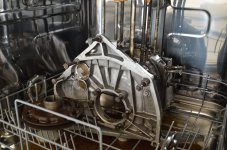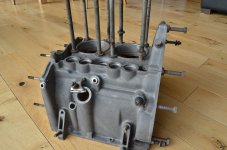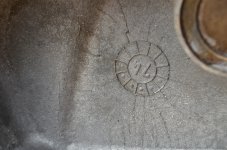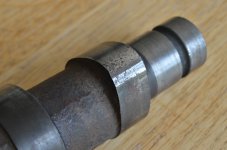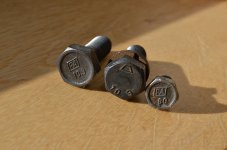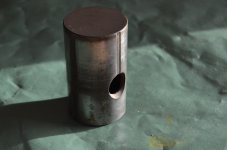Inspired by the guys at Project Binky, who have now reached the exciting, DOHC, Toyota Celica engine stage: https://youtu.be/cN8DYQIuW9Y, I decided it was time to get to grips with the much more sophisticated Fiat 594cc engine which has been lying around in bits for ages.
The crankshaft had already been surface cleaned with white spirit and wiped with lint-free paper-towel. Today I did a more thorough job and then blew it dry with the compressed air. I alternately taped over the oilway drillings for three out of the four journals and blew in at the end of the crankshaft. The result looks pretty clean (by my standards ) although it will get some final wiping and blowing before assembly.
) although it will get some final wiping and blowing before assembly.
I cleaned the crankcase twice using white-spirit and then put it in the dishwasher as with previous engines; who needs an ultrasonic cleaner? It's come out looking better than my previous 652cc crankcase; part of that is because the casting is more precise, having been made in Italy in June 1974.
It's come out looking better than my previous 652cc crankcase; part of that is because the casting is more precise, having been made in Italy in June 1974.
I had bought some new main bearings but the old ones measured up with minimal wear, being only 0.002mm greater in diameter than the new ones. Given that the construction of the originals seems better I cleaned them and they are ready to go back in.
So I'm ready for the straightforward process of assembling the crankshaft back into the case and then I'll get stuck into the pistons and barrels.
The crankshaft had already been surface cleaned with white spirit and wiped with lint-free paper-towel. Today I did a more thorough job and then blew it dry with the compressed air. I alternately taped over the oilway drillings for three out of the four journals and blew in at the end of the crankshaft. The result looks pretty clean (by my standards
I cleaned the crankcase twice using white-spirit and then put it in the dishwasher as with previous engines; who needs an ultrasonic cleaner?
I had bought some new main bearings but the old ones measured up with minimal wear, being only 0.002mm greater in diameter than the new ones. Given that the construction of the originals seems better I cleaned them and they are ready to go back in.
So I'm ready for the straightforward process of assembling the crankshaft back into the case and then I'll get stuck into the pistons and barrels.
Attachments
Last edited:



